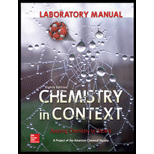
Concept explainers
(a)
Interpretation:
The region of the
Concept-Introduction:
Wavelength: The distance between successive peaks in a wave and measured in units of length.
Frequency: The number of waves passed a point in a certain amount of time.
Relation between wavelength and frequency:
Where, c is constant, the value of c is
Conversion of centimeter into meter (cm to m):
(a)
Explanation of Solution
The wavelength is
Conversion of centimeter to meter is,
Therefore, the given value of wavelength in meter is
(b)
Interpretation:
The region of the electromagnetic spectrum for the given wavelength has to be specified.
Concept-Introduction:
Wavelength: The distance between successive peaks in a wave and measured in units of length.
Frequency: The number of waves passed a point in a certain amount of time.
Relation between wavelength and frequency:
Where, c is constant, the value of c is
Conversion of micrometer into meter (
(b)
Explanation of Solution
The given wavelength is
Conversion of nanometer to meter is,
Therefore, the given value of wavelength in meter is
(c)
Interpretation:
The region of the electromagnetic spectrum for the given wavelength has to be specified.
Concept-Introduction:
Wavelength: The distance between successive peaks in a wave and measured in units of length.
Frequency: The number of waves passed a point in a certain amount of time.
Relation between wavelength and frequency:
Where, c is constant, the value of c is
Conversion of nanometer into meter (nm to m):
(c)
Explanation of Solution
The wavelength is
Conversion of micrometer to meter is,
Therefore, the given value of wavelength in meter is
(d)
Interpretation:
The region of the electromagnetic spectrum for the given wavelength has to be specified.
Concept-Introduction:
Wavelength: The distance between successive peaks in a wave and measured in units of length.
Frequency: The number of waves passed a point in a certain amount of time.
Relation between wavelength and frequency:
Where, c is constant, the value of c is
Conversion of millimeter into nanometer (mm to m):
(d)
Explanation of Solution
The given wavelength is
Conversion of millimeter to meter is,
Therefore, the given value of wavelength in meter is
Want to see more full solutions like this?
Chapter 2 Solutions
Laboratory Manual Chemistry in Context
 ChemistryChemistryISBN:9781305957404Author:Steven S. Zumdahl, Susan A. Zumdahl, Donald J. DeCostePublisher:Cengage Learning
ChemistryChemistryISBN:9781305957404Author:Steven S. Zumdahl, Susan A. Zumdahl, Donald J. DeCostePublisher:Cengage Learning ChemistryChemistryISBN:9781259911156Author:Raymond Chang Dr., Jason Overby ProfessorPublisher:McGraw-Hill Education
ChemistryChemistryISBN:9781259911156Author:Raymond Chang Dr., Jason Overby ProfessorPublisher:McGraw-Hill Education Principles of Instrumental AnalysisChemistryISBN:9781305577213Author:Douglas A. Skoog, F. James Holler, Stanley R. CrouchPublisher:Cengage Learning
Principles of Instrumental AnalysisChemistryISBN:9781305577213Author:Douglas A. Skoog, F. James Holler, Stanley R. CrouchPublisher:Cengage Learning Organic ChemistryChemistryISBN:9780078021558Author:Janice Gorzynski Smith Dr.Publisher:McGraw-Hill Education
Organic ChemistryChemistryISBN:9780078021558Author:Janice Gorzynski Smith Dr.Publisher:McGraw-Hill Education Chemistry: Principles and ReactionsChemistryISBN:9781305079373Author:William L. Masterton, Cecile N. HurleyPublisher:Cengage Learning
Chemistry: Principles and ReactionsChemistryISBN:9781305079373Author:William L. Masterton, Cecile N. HurleyPublisher:Cengage Learning Elementary Principles of Chemical Processes, Bind...ChemistryISBN:9781118431221Author:Richard M. Felder, Ronald W. Rousseau, Lisa G. BullardPublisher:WILEY
Elementary Principles of Chemical Processes, Bind...ChemistryISBN:9781118431221Author:Richard M. Felder, Ronald W. Rousseau, Lisa G. BullardPublisher:WILEY





